Virtually There, Fly-bys, Friendly Bots, Something from Nothing
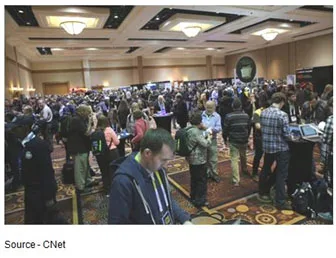
CES (Consumer Electronics Show) is just too much to take in and digest in a single long, painful week.
If you look at all the products in one category, you say the show is all about (pick your subject); but when you step back and analyze what you saw, there are product categories that were almost as amazing as the 4K TVs and cars–especially when you saw how much virtual reality (VR) has progressed, how much better robots have become and especially how 3D printing is going to be put to use.
A friend and industry analyst, Jon Peddie, has been oohhing and aahhing about VR since the beginning; but then, he’s more into immersive video gaming and video training than I am.
 Own World – Like Sherlock Holmes in the “Elementary” TV series, using the isolator, VR technology is still in its early stages but has made tremendous strides in recent years and software advances promise to give the technology a very real feeling of being there over the next couple of years.
Own World – Like Sherlock Holmes in the “Elementary” TV series, using the isolator, VR technology is still in its early stages but has made tremendous strides in recent years and software advances promise to give the technology a very real feeling of being there over the next couple of years.
Last year, Zuck thought enough of the infant VR space to plunk down $2B for Oculus Rift, one of the leaders in the VR space.
Sure, it’s great for playing really immersive games, putting yourself in the middle of a movie and most recently, testing the feel of vacation spots around the globe.
It isn’t exactly earthshaking, but when you think about it, it’s a great way to teach people on expensive systems (like aircraft, construction systems, space flight) and train them (military, police/emergency personnel) without endangering the trainee, the equipment or environment.
It really is an immersive experience.
The only thing lacking?
Compelling content!
While the Oculus Rift is a leader in the category, it still looks like what it is–an early stages design.
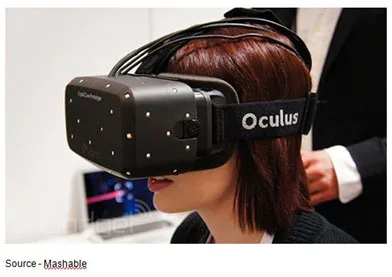 There and Back – Oculus is a leader in the VR field, giving the wearer the opportunity to experience everything around him/her without the danger. Next year, it could add a whole new dimension to video gaming.
There and Back – Oculus is a leader in the VR field, giving the wearer the opportunity to experience everything around him/her without the danger. Next year, it could add a whole new dimension to video gaming.
That’s O.K. if you’re a dedicated gamer; but you’d have a tough time talking your mom into strapping it on and I doubt if any date would want to come to your place to play with your Rift.
The beginning of the VR movement also saw Samsung introduce their Milk VR platform, a much more stylish, consumer friendly piece of gear.
HP unveiled their Zyr Virtual Reality Display, Razer launched their OSVR and 3DHead was there with their “Oculus Rift Killer”.
All of the solutions were still only appealing to the early adopters; but by E3, the gaming industry’s big event later this year, you’ll probably see more attractive and improved hardware and software.
The key will be how quickly Sony and MS add the “accessory” to their game consoles.
The technology will really come into its own though when you can reach things and do stuff in the virtual world and not just be an interested bystander.
Gamers can really sweat bullets then but more importantly, it will deliver the complete interactive experience that thousands of immersive training and education applications require.
As one analyst said, “The stuff is good and it will get better.”
Maybe by 2017, you’ll be able to go to CES without really going … which would be a helluva’ lot easier on the feet!
iPilot
There’s a ton of great applications for drones; and despite what Amazon says, I think it will be a long, long time before their fleet puts FedEx and UPS out of business.
USPS, maybe.
This year, there were even more of the suckers flying around as “pilots” touted all the things you could do with them beyond peeking in your neighbor’s bathroom or watching him/her sunbathe in the backyard.
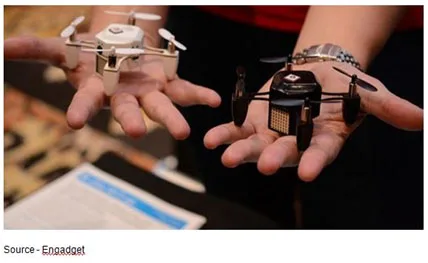 Dragonfly Fliers – Drones came in an almost unbelievable array of sizes, colors and complexity; ranging from handheld models like those above to larger units for surveillance and monitoring.
Dragonfly Fliers – Drones came in an almost unbelievable array of sizes, colors and complexity; ranging from handheld models like those above to larger units for surveillance and monitoring.
Except for the huge units that the military use (and they may have been in an invasion-only place or flying overhead), CES had more than its share of buzzing units, many with Intel inside.
Often billed as the next great delivery service, these remote-controlled flyers have already enticed many pilot training schools to convert their courses from plane control to drone pilot licensing.
The rapid early adoption of the technology by anyone willing to pay for them is already causing the FAA (Federal Aviation Administration) to take a long, hard look at their aerial licensing and clearance regulations before something serious happens beyond near misses and drone crashes.
Photojournalists are already using drones to check things like the progress on Apple’s spaceship headquarters, getting startling photos/footage of fires, accidents and natural disasters.
Law enforcement, emergency personnel and disaster assessment organizations around the globe are putting drones to use on a daily basis to get a clear understanding of the depth and breadth of situations before personnel are dispatched.
But as one person noted regarding the drone invasion, “There will be some misuse of them by law enforcement and emergency personnel. It’s inevitable,” he commented, “but those situations will be quickly corrected.”
His concern was that there will be 10s of thousands of the things flying around being used for uncontrolled ‘observation’.
“That is scary,” he noted.
But he added that there are hundreds of practical applications beyond questionably faster delivery of packages such as search and rescue in rugged terrain, environmental studies in hazardous areas, traffic studies and the like.
“Every technology has its bright and dark side,” he concluded.
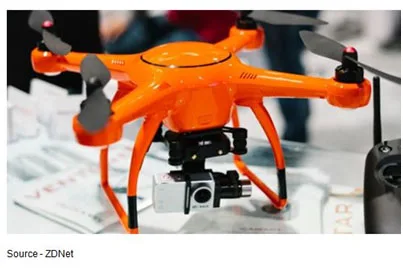 Camera, Action – While drone makers are clearly initially targeting the enthusiast and early adopters, drones with cameras attached are becoming a part of filmmakers’ field kits to capture scenes in new, unusual ways. Of course, they can also be used to invade your neighbors’ privacy, which worries the legal profession.
Camera, Action – While drone makers are clearly initially targeting the enthusiast and early adopters, drones with cameras attached are becoming a part of filmmakers’ field kits to capture scenes in new, unusual ways. Of course, they can also be used to invade your neighbors’ privacy, which worries the legal profession.
I was discussing the issue with Dave Helmly, of Adobe, and he agreed that there will be some abuse and probably a new “service” emerging for aerial selfies that could rival today’s smartphone selfie avalanche.
However, being extremely close to the broadcast and film industries, he said the units are in the field gear kit of almost every production being planned and shot today.
“The great thing is you can buy one for your video projects to fit into your budget–even if you’re an independent filmmaker,” he explained. “A lot of people who use their own money to create a documentary or simply post short films on the Web’s streaming video services are getting great footage whether they’re using GoPros, Blackmagic units or larger, more expensive cameras attached to appropriate size drones.”
For almost every filmmaker, there’s a drone/camera package available that will put you in the thick of things when the production is complete.
“If you want to get an idea of how creative people are, just look at the GoPro channel,” he noted. “Some of that footage is eye-popping in quality and breathtaking in execution.”
iRobot
The robots have at this year’s CES have grown up quite a bit and do a lot more than just scoot across the floor cleaning and scaring the cat.
And they’re a whole lot more friendly looking (and more versatile) than those big automated arms I’ve seen manufacturing Teslas.
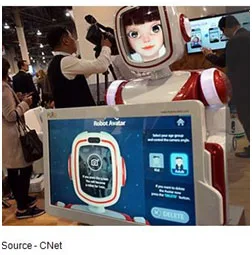 Friendly Face – While Honda’s ASIMO has been around so long it almost seems like a friend, a number of the new breed of bots have tablet screens that show an even more friendly image. The goal of manufacturers is to see one in every home.
Friendly Face – While Honda’s ASIMO has been around so long it almost seems like a friend, a number of the new breed of bots have tablet screens that show an even more friendly image. The goal of manufacturers is to see one in every home.
More than a dozen companies wee at this year’s show to persuade us that their friendly bots will increasingly be used in your home and office.
Lots of them are incorporating a table to put a human or more friendly face on the little mechanical marvel like Juro-I Home’s unit above.
Intel has a major robot program to help firms develop and implement sensors that can monitor the environment, recognize faces and exchange information in a “near human” tone.
Today’s robots are a lot more versatile and friendly than The Jetson’s Rosie and prices range from under $500 to $3,500 and up, depending on the capabilities you’re looking for.
The growing family of robots can monitor, evaluate and report situations so adults can determine what actions – if any – need to be taken.
Most of the robots being shown at CES this year were limited in their capabilities; but as one executive noted, there will be more apps for that.
With every company in the industry pushing schools to help develop new engineers and software programmers, Ozobot generated a lot of excitement at the show.
 Programming Game – The surprisingly inexpensive Ozobot was introduced at CES to help youngsters learn programming and expand their interest in technology areas as they get older.
Programming Game – The surprisingly inexpensive Ozobot was introduced at CES to help youngsters learn programming and expand their interest in technology areas as they get older.
You had to look for it to find it, but the one cubic inch Bit was designed specifically to help kids learn programming. Available for iOS or Android, you can transmit instructions to the Bit to be carried out. The friendly little sucker will detect and follow lines on a surface and change behavior based on the color of the lines.
Costing less than a week’s worth of Starbucks coffee, it’s a great way for youngsters to learn software programming so they can explain it to their parents.
Print it
3D printing emerged a couple of years ago as a something you’d expect to see in StarTrek – you can imagine something and in a few minutes (or so), you could hold it in your hand.
This year, the technology had its own pavilion but still it was the “No S***” stuff that grabbed the media’s attention.
You know, like Intel’s spider dress?
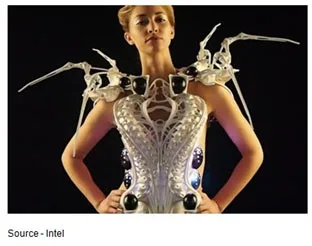 Spiderwoman – Intel’s 3D-produced spider dress drew a lot of attention at this year’s CES. Get a little too close to her and the spider arms extend to “discourage” close encounters. It worked.
Spiderwoman – Intel’s 3D-produced spider dress drew a lot of attention at this year’s CES. Get a little too close to her and the spider arms extend to “discourage” close encounters. It worked.
Spooky!
There have been a lot of hints as to how the technology can be put to useful and economically feasible use over the past year by printing:
- Working weapons (not my favorite, but it worked)
- Prosthetic front legs for a cute little dog (the video went viral)
- Kidney and liver transplants and eventually working hearts (still in trial stages, but progress is steady)
- A wrench on the space station by sending the instructions/signals up rather than another spaceship
- One-off fashion designs
- Menu- driven field rations for military personnel
Even though the industry is very young, Stratasys/Makerbot and 3D Systems are leading the hardware side using Autodesk’s design/production software.
Printing food for home – chocolate, pizza, whatever – sorta’ creeps me out but then, I’m not a fan of chocolate or pizza.
It is interesting though.
The 3D printer producers worked hard to show how the units could be used in every home to knock out new dinnerware, lamps, toys, furnishings, clothes, you name it.
 Dinnerware – To show the “practical” side of 3D printing, MarketBot showed off specially designed Martha Stewart dinnerware to CES attendees.
Dinnerware – To show the “practical” side of 3D printing, MarketBot showed off specially designed Martha Stewart dinnerware to CES attendees.
A number of designers (and printer manufacturers) worked hard to show CES attendees that tomorrow’s fashion leaders could be unique one-off designs you designed/produced yourself.
But my guess is that the 3D printer in every home is a nice idea but about as practical as photo printers in every home.
It’s a helluva’ idea but the devices are still finicky, slow and every print is expensive (maybe I’ll go back to Polaroid).
I can see 3D printing service bureaus for:
- Really extra special jewelry … done!
- To replace an obsolete part on an old car you really love … done!
- For gotta’ have evening clothes you’re sure no one will have for the party … done!
- Special, high-value manufacturing components … done!
- A toy for a spoiled brat you’re absolutely certain no one else will have … why?
The auto and transportation equipment industries are already spending upward of $500M producing parts that have a high value and show that additive manufacturing doesn’t have to be complicated or unit-cost prohibitive.
Presently being used for vehicle (road/air/sea) prototypes, designers and engineers (and industry analysts) believe 3D part/component printing could be a common practice in the next three years.
We can see the use in producing engine, frame and other parts for test vehicles. I’m sure it will be a whole lot less expensive than building a manufacturing facility for each specific unit and a whole lot faster.
SmarTech says that within five years the auto/transportation equipment industries could represent in excess of $5B.
I can believe that, but food?
I’m not even sure what’s in a McDonald’s burger!
# # #